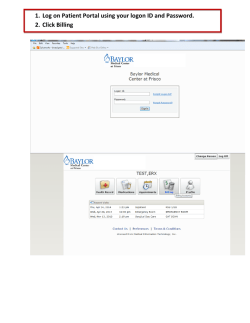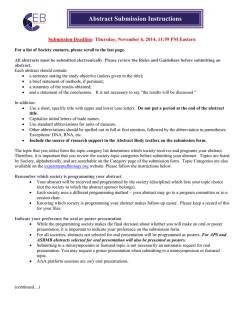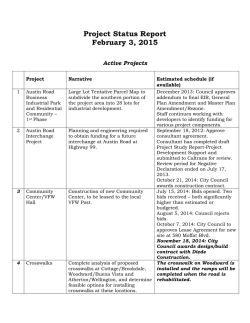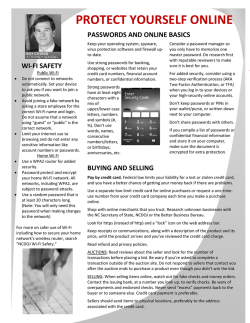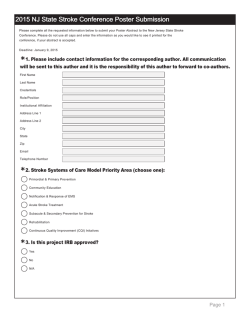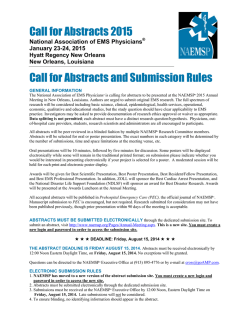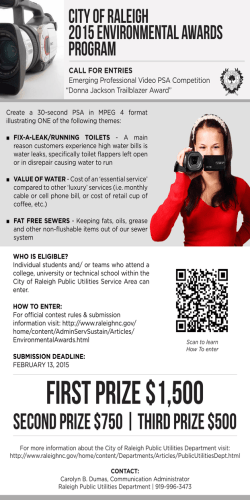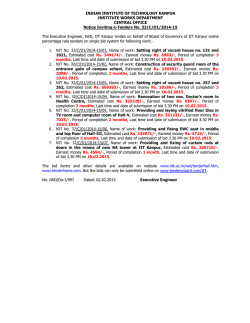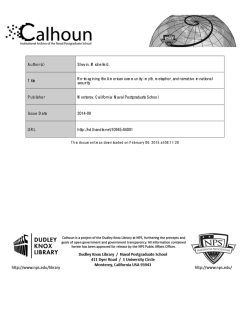
Download instructions for online submission of research grant
Instructions for Submission: Research Grant Applications National Multiple Sclerosis Society February 2015 INTRODUCTION Please read these instructions and follow them carefully. Applications that are incomplete, exceed the page limitations, or use undersize or condensed type will not be considered for funding by the Society. The following changes to the Society’s application procedures have been implemented: A new grants management system called MSGrants has been implemented for preparation and submission of research proposals to the Society. MSGrants can be found at https://nmss.fluxx.io Compatible browsers include Chrome, Firefox, and Safari. Internet Explorer is not fully compatible and should be avoided. Check with your IT department for information on installing one of these browsers if you do not already have one. Passwords for accessing the site never expire and a new password will not be needed for each cycle. Submission of proposals is exclusively electronic for all parts of the proposal, including institutional approval and appendix materials, and no paper copies of any part of the proposal will be sent to the Society. In place of the former coversheet, institutional approval by your organization to submit your application will be made electronically using the same online system. The application process itself consists of two parts, a short pre-application and the full application. The basic elements of the application remain largely unchanged but have been reordered and reformatted compared to our former system. Details concerning the grants management system and application process can be found in these instructions and on the system’s Web site itself. GETTING STARTED If you have already been issued a password for MSGrants, you can skip the next two sections. Registration for New Users If you did not have a password for our previous system, mssocietyapplyonline, you will need to register and be approved for access to the new system. Go to https://nmss.fluxx.io and once you are at the login page, click on Register Now. Complete the online registration form and submit your registration by clicking on the words Submit Request. This will submit your request for access to the site to the Research Programs staff of the Society. The staff will review your registration information to verify that you are qualified to apply for funding from the Society. If approved, you will receive an automated e-mail message containing your login credentials within two business days. Registration for Existing Users If you have a password for our previous system, you do not need to register again, however you will need to reset your password. Go to https://nmss.fluxx.io and once you are at the login page, click on Reset or Create Password. At the next screen, enter the e-mail address that you used in the old system and click on Submit. The system will send you an e-mail with a link to reset your password. If the system does not recognize your e-mail address, you will need to register as if you are a new user. A Word about Passwords Once you have obtained a user id and password, go to https://nmss.fluxx.io and log in. Once you log in, you will be able to see which funding opportunities are active along with the deadlines for each. You will also be able to begin the preparation of your preapplication. In the system your password never expires and you will not need to obtain a new password in order to apply for other funding programs or subsequent cycles. You will be using MSGrants for a variety of purposes in addition to preparation and submission of proposals. For example, progress reports will be prepared and submitted through MSGrants as well and you will be able to view proposals that you have prepared on the system. It is important that you not share your password with others and it is not possible for two different people to apply for funding opportunities using a single password. Updated 11/1/2014 2 NAVIGATING MSGrants When you log on you will see the grantee portal (illustrated below). A description of the main parts of the grantee portal follows below. Application Information Click on this item to see the funding opportunities that are currently available and the application deadlines. Click on Apply Now to start a pre-application. Application Templates Click on this item to download any of several documents that you are likely to use in preparing your application. These include the following: A PDF file showing the keywords that you will also find in a drop down list in the application. This PDF file is provided to make it easier for you to see the entire list before making your selections. A Word template to use for preparing the narrative for pilot grant applications. A Word template to use for preparing the narrative for research grant and Health Care Delivery and Policy Research contract applications. 3 A Word template to use for preparing biographical sketches. Instructions for submission An example of a lay summary My Profile Clicking on My Profile will open your individual record. Once open, click on Edit to modify your profile. Open Pre-Applications As your application moves through the various steps in the system, it will be listed under different sections of the grantee portal. Once you have started a pre-application and saved it, you can retrieve the application to continue to work on it by clicking on the Open Pre-Applications link. Pending Approval Once you have submitted a pre-application you can find it by clicking on the Pending Approval section. Pre-applications listed in this section cannot be edited. Open Full Applications Once your pre-application has been approved to move on to a full application, you can access the full application forms here. Full applications that you have worked on and saved can also be found here. These applications can be edited. Submitted Applications Full applications that have been submitted can be found here. Applications in this section cannot be edited. Awaiting Institutional Approval Full applications that are pending institutional approval for final submission can be found here. Revisions Requested Both pre-applications and full applications that have been sent back to the applicant for changes requested by Society staff can be found here. Applications in this section can be edited. Under Review Full applications that have been screened by Society staff and advanced to the peer review process can be found here. Applications in this section cannot be edited. Updated 11/1/2014 4 Pending Agreement Full applications that have been approved for funding but which still require some additional processing and/or submission of documents can be found here. Approved Full applications that have been approved for funding and which require no further processing can be found here. THE PRE-APPLICATION In the past prospective applicants were required to contact a member of the Society’s Research Programs staff to obtain clearance before submitting a proposal. While the Society still encourages personal contact and discussion of possible ideas for proposals, in the current system this process has been formalized through the use of a “Pre-Application” step. For each funding opportunity, there is a pre-application that must be completed and submitted to the Society before the applicant can prepare a full application. The pre-application is reviewed by a member of the Research Programs staff to ensure that the research idea is consistent with the Society’s mission and research strategies and the nature of the specific funding opportunity. Once the idea is approved you will receive an automated message from the system and you will be able to begin preparation of the full application. In some cases, Society staff may send the pre-application back to you for clarification or changes before final approval. How to Complete the Pre-Application Once you are logged in, click on Application Information to see a list of available funding opportunities, along with information on the application deadlines. Find the funding opportunity to which you wish to apply and click on Apply Now. This will open the pre-application. Enter a title for your pre-application (this can be changed later) and complete the Eligibility Quiz. The Eligibility quiz will establish whether you are eligible to apply for that funding opportunity. If you pass all of the eligibility criteria, the rest of the pre-application will open and you can begin to complete this step. If you fail one or more of the eligibility criteria, you will not be able to prepare and submit a preapplication for that program. Organization: If you have only one organizational affiliation, the Organization field will be pre-populated. If you are affiliated with more than one organization, select the organization that will be the applicant organization from the drop-down list. Principal Investigator: In the Principal Investigator field, select your name from the drop-down list. Primary Signatory: This is the individual who “signs off” on the application on behalf of your institution, thereby allowing the application to be submitted. If you do not know who this is, just leave it blank and you will have another opportunity to complete this field later. 5 Project Details: In the Project Details text box, insert a brief (500 words or less) description of your proposed project. You can type this in online, or prepare it off line and copy and paste the text into the text box. Project Zip Code: In the Project Zip Code field enter the zip code (U.S. applications) where the work will actually be done. If more than one site is going to be used, this should be the Zip code of the primary or lead site. Estimate of Amount Requested: In the Estimate of Amount Requested field, enter your best estimate of the total cost of your proposed project, including 10% indirect costs. Indirect costs are only allowed on U.S. based projects. This figure is just to allow Society staff to gauge the overall amount of funding that is likely to be requested during a given cycle. This figure will not be used to evaluate whether or not to approve your pre-application and you will be able to change this figure later. Once you have completed all sections of the pre-application, click on Save to save your work. At this point you can log out and return later to revise your preapplication by pressing the Edit button, or you can click on Submit to submit your pre-application to Society staff for approval. Saving your application does not send it to Society staff. You must click on Submit in order for it to be considered for approval. Once you press Submit, you will no longer be able to make changes, although you will be able to see your pre-application. When you submit the pre-application, it will automatically be sent to the appropriate program officer at the Society for review. You will receive notification of approval, disapproval, or the need for changes within two business days. THE FULL APPLICATION Once your pre-application has been approved (generally within two business days) you can log in and begin to prepare the full application. At the grantee portal, click on the Open Applications link and then on Edit to begin working on the full application. You can work on the various parts of your full application in any order you want, save your work, and return to continue working as many times as you want. Navigation Tips There are two types of sections in the application: 1) sections in which you select options or fill in text boxes; and 2) sections in which you upload one or more documents. It is a good idea to click on Save as you complete each part of the application. Black triangles indicate a section that will open when you click on the triangle. These can either be drop-down lists, text boxes, or sections where you need to upload one or more files. After you complete a given section, clicking on the triangle again generally closes that section. Sections that require one or more files to be uploaded will have a white plus sign on a green background. Click on the plus sign to open the upload dialogue. Click on Add Files to browse for the file that you want to upload. Click on the black triangle to Updated 11/1/2014 6 indicate the type of document you are uploading. Click on Start Upload to upload the file. To change the document type or delete the file that you uploaded, position your cursor anywhere to the right of the name of the file and click on the pencil (edit) or the minus sign (delete) that appear. You can complete the sections in any order you wish but all sections must be completed before you can submit. Project Information This section includes basic information about the proposed project. To assist you in selecting the Keywords that are a required part of this section, a list of available keywords can be downloaded from the Grantee Home Page. Institutional Official In this section you will indicate the institutional official who will be the Primary Signatory for submission of your full application. This is the individual who “signs off” on the application on behalf of your institution, thereby allowing the application to be submitted. You indicate who this is by selecting the individual’s name from the drop-down list of appropriate individuals associated with you institution. The primary signatory must be registered with the system in order for you to make this selection from the drop-down list. If the primary signatory is not registered, this individual must go to the MSGrants log on page https://nmss.fluxx.io and register. Your application is not actually submitted to the Society until the Primary Signatory has logged on to the system and authorized submission of the application. The Primary Signatory must be registered with the system and must be the individual designated by you in the Institutional Official section of the application. Once you have submitted your application, a system message will be sent via e-mail to the Primary Signatory stating that an application is pending authorization. The Primary Signatory must then log on to the system, open the application, and complete the authorization. This must be completed prior to 11:59 PM Eastern Time on the date of the deadline. 7 In this section you will also confirm the location of the project and the name of the principal investigator. Human Subjects and/or Vertebrate Animals This section includes information on protection of human subjects and animals. If any documents concerning these assurances need to be included, such as IRB approval memos, they must be included along with any letters uploaded in PDF format as part of the application. (See next section) Letters Submitted with Application This is the section where letters submitted with your application are uploaded. Letters must be converted to PDF format and uploaded as a single PDF file. Paper copies will not be accepted and will be discarded if they are received by the Society. Most letters to be submitted fall into the following three categories: Collaborative Arrangements - Letters of collaboration/support from all individuals whose cooperation is necessary for the proposed research should be included as part of the single PDF file uploaded in the Letters section. Research involving Human Subjects - If your proposed research involves human subjects, you must provide a signed and dated approval letter from the Institutional Review Board or equivalent appropriate committee of your institution as part of the single PDF file uploaded in the Letters section. If approval is pending, indicate that the project has been submitted to the committee for review in the Human Subjects section. Payment for a successful application will not begin until such signed and dated approval is received, reviewed and approved by the Society. Research involving Vertebrate Animals - If you plan research with experimental animals, you must provide certification that the institution complies with all federal, state and local regulations and with the standards established by the Animal Welfare Acts and the documents entitled "Principles for Use of Animals" and "Guide for the Care and Use of Laboratory Animals", available from the Office of Laboratory Animal Welfare at http://grants.nih.gov/grants/olaw/olaw.htm. If approval has been granted, a copy of the signed and dated approval letter must be submitted as part of the single PDF file uploaded in the Letters. If approval is pending, indicate that the project has been submitted to the committee for review in the Vertebrate Animals section. Payment for a successful application will not begin until such signed and dated approval is received, reviewed and approved by the Society. Lay Language Summary of Proposed Project The lay language summary should describe your proposed research in language suitable for a news release to the lay public. The lay summary is broken into several sections. In each section you are required to address a different element of your proposed project. Please read these instructions carefully and ensure that you address each element. You can type directly into the online text boxes or copy and paste each Updated 11/1/2014 8 section that you have prepared using a word processor. If your project is funded, Society staff may make editorial changes to the summary to enhance its clarity. Scientific Summary of Proposed Project This summary should capture in condensed form the rationale, specific aims, methods, anticipated outcomes, and potential significance of the proposed research. You can type this into the online text box directly or copy and paste a summary that you have prepared using a word processor. Project Staff Since the PI’s information is already captured elsewhere, it does not need to be entered here. However other key professional personnel should be listed. This will assist the Society in more effectively tracking all of the researchers and clinicians who participate in Society-funded projects. Biographical Sketches A biographical sketch template is provided for downloading on the Grantee Home Page in case you need one. If you already have a current biographical sketch, you can convert it to PDF format and upload it. Biographical sketches are required for all professional personnel working on the project. All biographical sketches must be uploaded in PDF format. Other Support The Society requires detailed information concerning current and pending support for personnel listed on the application. This information is useful in evaluating any potential overlap with the current application and in identifying potential conflicts of interest. Proposal Narrative The proposal narrative is the heart of the application. Details concerning the preparation of the proposal narrative appear below. A template in Microsoft Word format is provided on the Grantee Home page for downloading. This template parallels NIH format. Specifications are 12 pages single spaced (not including references), 11 point or larger font, and half-inch margins on all sides. Once the narrative is completed, it must be converted to PDF format and uploaded in this section. Applicants who have a narrative prepared for a NIH application can use this if it conforms to the above dimensions. Applicants who are resubmitting an application must include up to 2 pages detailing their response to the reviewers’ comments from the prior submission. These 2 pages are in addition to the 12 pages of the narrative itself. 9 Materials Submitted with Application This is the section where appendix materials submitted with your application are uploaded. Appendix materials must be in PDF format and can be uploaded as multiple PDF files. Paper copies, CD’s, etc. will not be accepted and will be discarded if they are received by the Society. Items commonly included in the appendix are: Publications – Reprints, preprints, manuscripts, etc. that are relevant to the proposed project can be included as part of the appendix. Clinical Trial Protocols – In some cases, a proposal submitted to the Society may involve a study that is an add-on to a clinical trial that has been funded by another agency. Although the clinical trial itself is not the focus of the proposal, it is essential for the peer-review panel to have detailed information about the trial. If the above scenario describes your proposal, you must include a copy of the clinical trial protocol as part of the appendix. Other Materials – If your proposed study utilizes questionnaires or other types of printed assessment instruments, you may want to include these as part of the appendix. Many other types of materials could potentially be included in the appendix. However keep in mind that reviewers have a great deal of material to review and so you should choose your appended materials carefully. Caution – Do not use this section to circumvent the page limits of the narrative section. Putting information here that belongs in the narrative may result in a more negative assessment by the peer review panel. Budget The Society requires a detailed budget for all years of the proposed project. The budget must be prepared using our online facility. The budget module is divided into sections such as “Personnel,” “Equipment,” “Supplies,” etc. and project years. To add a line item to the budget, click on the green "+" button to open the form. The system will calculate the total budget per year after each line item has been added to the application. Please note, it is recommended that you save the application after each budget section has been completed to expedite the calculation process. The budget module automatically calculates direct costs, indirect costs, and totals. Please note that you cannot edit the indirect cost section. This section is calculated by the system based on your entries and is not editable by applicants. Sub-Contractor Budget The online system also includes the ability to calculate subcontract budgets and integrate them into the main budget. Like the overall budget, any subcontractor budgets should provide budget detail for all years of the project. The Society will pay up to 10% indirect costs on subcontracts to US institutions, with the usual exclusions for equipment and patient costs. The subcontractor budget should include indirect costs, if applicable. Updated 11/1/2014 10 However in the main project budget, only the direct costs for the subcontract should be included since the Society will not pay indirect costs twice on the subcontract amount. Budget Justification The budget justification can be typed directly into the text box online or copy and pasted into the text box from a word processor. Sub-Contractor Budget Justification The budget justification can be typed directly into the text box online or copy and pasted into the text box from a word processor. ORGANIZING YOUR NARRATIVE To facilitate the review of your application, it is strongly recommended that you organize the discussion of your proposed research using the following guidelines: Introduction (for resubmissions only) Use this section only for a revised, resubmitted application. In a revised application, there must be substantial changes in the content of the application. This section must summarize the substantial additions, deletions, and changes. The Introduction must also include responses to the criticisms and issues raised by the reviewers of your previous application. The changes in the Research Plan must be clearly marked by appropriate bracketing, indenting, or changing of typography, unless changes are so extensive as to include most of the text. This exception should be explained in the Introduction. Do not indicate changes by colored text or shading. Work accomplished since the original application was submitted should be included in the "Progress Report/Preliminary Results" section. PAGE LIMIT: two pages (This can be in addition to the 12 page limit.) If you exceed two pages, your application may be rejected. Research plan Include all text, figures, and data tables related to the research plan in this section. The individual subsections below may be any length as long as the total for the entire research plan does not exceed the PAGE LIMIT of twelve pages (not including the list of literature references). Specific Aims - Provide a concise statement of each objective of the proposed research project. Background - Provide a brief summary of the background for this project, including existing knowledge in the area and long-term goals of your research. Progress Report/Preliminary Results - A progress report is required for renewal applications. For new applications, use this section to report the principal investigator's preliminary studies pertinent to the application. Include any information 11 that will help establish the experience and competence of the investigator’s to pursue the proposed research. Experimental Design and Methods - Describe the design of experiments and the procedures used to undertake the proposed studies. Where appropriate, include possible outcomes, pitfalls, and alternative plans. Relevance to Multiple Sclerosis - Describe the relevance of your proposed studies to the human disease, multiple sclerosis. Indicate how your project will support to the Society's mission, ‘We mobilize people and resources to drive research for a cure and to address the challenges of everyone affected by MS’ and the Society’s research priorities” Facilities Available – Describe the facilities available for the conduct of the proposed research, and list major items of equipment that are available for use in the project. PAGE LIMIT: one page. Literature cited To facilitate the review of your application, give the full title and bibliographic reference for all work cited in your application. Please note that the 12-page limit for the narrative does not include the references, i.e., the references can go beyond the 12-page limit. DUAL SUBMISION TO OTHER AGENCIES You are encouraged to apply to other appropriate agencies, in addition to the National Multiple Sclerosis Society. If you apply to another agency for support of the same or similar project, be sure to acknowledge the application(s) in the Other Support section and where indicated on the Project Information Section of the Apply Online system. SUBMISSION OF YOUR PROPOSAL Once you have completed the preparation of your proposal, there are several options. Edit If you have not as yet submitted your proposal, you can click on the Edit button in order to open your proposal for further editing. Printable You can click on the Printable button in order to see your proposal as a single document which can be printed or outputted as a PDF file using standard browser commands. Submit If you have completed preparation of your application, you can submit it. Updated 11/1/2014 12 Save If you are not ready to submit your application, you can save it to work on it later. Withdraw (application) If you do not wish to submit your proposal or continue working on it, you can Withdraw it. Once you withdraw an application, it cannot be recovered and so consider this option carefully. This option is generally used when an investigator has inadvertently started a duplicate application. The Submission Process Once you are satisfied with your proposal and all sections are marked as “complete,” you can click on the “Submit” button. This will lock your proposal for further editing and move it to the Authorization step. Cover Page In our system there is no cover page, cover sheet, or signature page. In place of the former cover page, the system uses an online Authorization step that is completed by the Primary Signatory. Authorization (Institutional Approval) Your application is not actually submitted to the Society until the Primary Signatory has logged on to the system and approved submission of the application. The Primary Signatory must be registered with the system and must be the individual designated by you in the Institutional Official section of the application. Once you have submitted your application, a system message will be sent via e-mail to the Primary Signatory stating that an application is pending authorization. The Primary Signatory must then log on to the system, open the application, and complete the authorization. This must be completed prior to 11:59 PM Eastern Time on the date of the deadline. 13 CHECKLIST To assist you in verifying that you have completed all steps in the application process, here is a checklist that you can use once you are ready to submit your proposal. □ □ □ □ □ □ □ □ □ □ □ □ □ □ □ □ □ Have you completed all required items in the Project Information section? Have you completed all required items in the Institutional Official section? Have you completed all required items in the Human Subjects and/or Vertebrate Animals section? If applicable, have you uploaded all of the Letters of support/collaboration/approval? Have you completed the Lay Language Summary? Have you completed the Scientific Summary? Have you listed all professional staff in the Project Staff section? Have you uploaded Biographical Sketches for all professional staff on the project? Have you listed Other Support for all professional staff on the project? Have you uploaded your completed Proposal Narrative? If applicable, have you uploaded all of the Materials in the appendix? Have you completed the Budget for all years of the proposed project? Have you completed the Budget Justification for all years of the proposed project? If applicable, have you complete the Subcontract Budget(s) for any subcontracts? If applicable, have you uploaded a Budget Justification for any subcontracts? Has the Primary Signatory of your organization Authorized submission of your application? Have you submitted your proposal prior to 11:59 PM Eastern Time on the date of the deadline? Updated 11/1/2014 14 HELP IS AVAILABLE Basic questions about word processing functions such as copying and pasting, pagination, etc. and questions concerning PDF files should be referred to your organization’s IT department or a colleague. If you have any questions concerning the online application process such as using the online screens, file uploads and downloads; questions about National Multiple Sclerosis Society policy or the content of your proposal, please contact one of the following members of the Research Programs team: Contacts Phyllis Motta (212) 476-0518 [email protected] Paula Mullings (212) 476-0418 [email protected] Tricia Denton (212) 476-0413 [email protected] Nicholas G. LaRocca, Ph.D. (207) 443-4299 [email protected] Please note that online and telephone support is only available Monday through Friday from 9 A.M. to 5 P.M. Eastern Time. 15
© Copyright 2025
